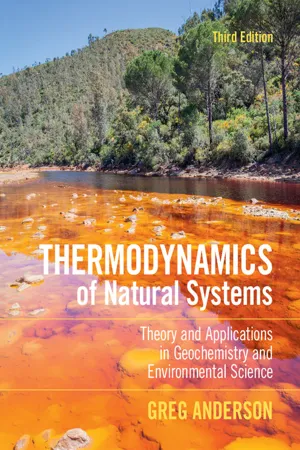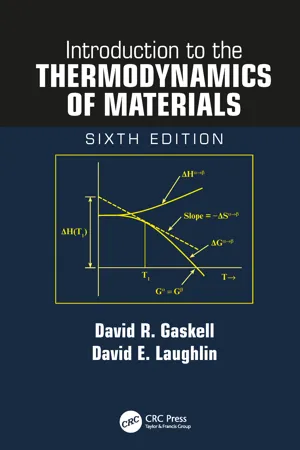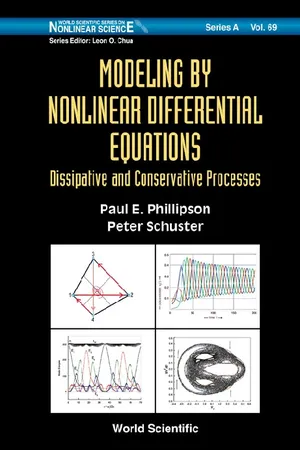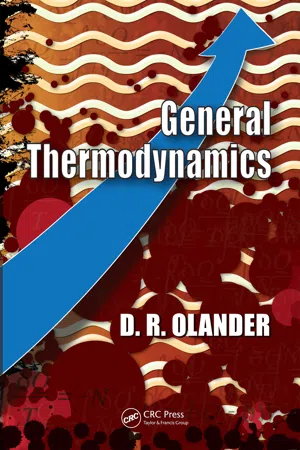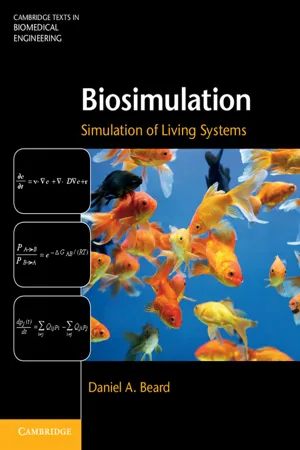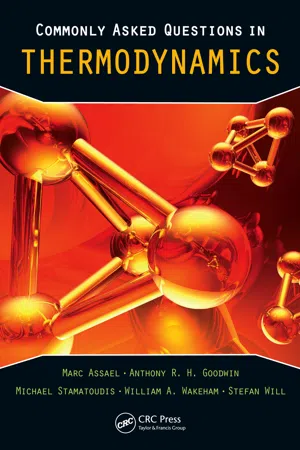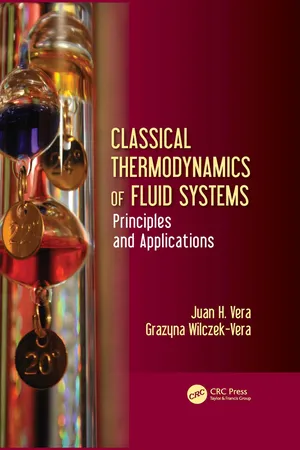Chemistry
Closed Systems
Closed systems in chemistry refer to systems where no matter can enter or leave the system, but energy can be exchanged with the surroundings. This means that the total amount of matter within the system remains constant, but there can be changes in energy. Closed systems are often used in chemical experiments and industrial processes to study the behavior of substances under controlled conditions.
Written by Perlego with AI-assistance
Related key terms
1 of 5
12 Key excerpts on "Closed Systems"
- eBook - PDF
Thermodynamics of Natural Systems
Theory and Applications in Geochemistry and Environmental Science
- Greg Anderson(Author)
- 2017(Publication Date)
- Cambridge University Press(Publisher)
As mentioned above, most natural systems are open. There are equations for open systems, those that can change composition, and we will introduce them (in Section 4.13 ), but we don’t use them to any great extent. It is possible and more convenient to model them as Closed Systems; that is, to consider a fixed composition, and simply ignore any possible changes in total composition. If what happens because of changes in composition is important, it can often be handled by considering two or more Closed Systems of different compositions. Thus we will be dealing mostly with Closed Systems in our efforts to understand chemical reactions. Basically this means that we will be concerned mostly with individual chemical reactions, rather than with whole complex systems. In other words, even though a bacterium is an open system, it can be treated (modeled) as a closed system while considering many individual reactions within it. The reactants may need to be ingested and the products eliminated by the organism, but the reaction itself can be modeled independently of these processes. This greatly simplifies the task of understanding the biochemical reactions. The same is true of most geochemical and environmental systems. The most common kind of open system in chemical thermodynamics is represented in Figure 2.2 (b), that is, two open subsystems within an overall closed system. There can be any number of these “open subsystems” or phases, and finding out how many there are and what their compositions are, given some physical conditions, is a common problem in the application of thermodynamics. 14 Defining Our Terms (a) (b) (c) Figure 2.2 (a) Isolated system. Nothing can enter or leave the system (no energy, no matter). Whatever is inside the walls (which could be anything) will have a constant energy content and a constant composition. (b) Closed system. The closure is a piston to indicate that the pressure on the system is under our control. - No longer available |Learn more
- David R. Gaskell, David E. Laughlin(Authors)
- 2017(Publication Date)
- CRC Press(Publisher)
simple thermodynamic systems , the surroundings interacts with the system only via pressure and temperature changes. The composition remains constant in simple systems.It is convenient to characterize systems by the kinds of interactions that are allowed between them and their surroundings.1.Isolated systems : In these systems, no work is done on or by the system. In addition, energy or matter may not enter or leave it. Thus, the energy of these systems remains constant, as does the overall composition. Isolated systems are therefore unaffected by changes in the surroundings.2.Closed Systems : These are systems which may receive (or give off) energy from (or to) the surroundings. The boundaries are called diathermal ; that is, they allow thermal energy to transfer through them into or out of the system. However, the boundaries are impermeable to matter; hence, the amount of matter is constant in these systems.3.Open systems : These are systems which can exchange both energy and matter with the surroundings. Neither the energy nor the composition of these systems need remain constant. The boundaries are both permeable and diathermal.The boundaries or walls of the system are classified as follows:•Adiabatic : No thermal energy can pass through.•Diathermal : Thermal energy can pass through.•Permeable : Matter can pass through.•Impermeable : Matter cannot pass through.•Semipermeable : Some components are able to pass through, while others are not.It is evident that when evaluating a system, it is important that its interactions with the surroundings be either known or determined.The macroscopic property of systems called temperature is a distinguishing aspect of the subject of thermodynamics. Temperature is not utilized in the mechanical description of matter (mass, velocity, momentum, etc.) encountered in introductory physics courses. The discovery that mechanical energy could be converted to thermal energy (via friction) was an important early step in the development of thermodynamics. Later, the conversion of thermal energy into mechanical work, or other forms of energy, became a focus of classical thermodynamics. This will be discussed in the introduction to the First Law of Thermodynamics in Chapter 2 - eBook - PDF
Modeling By Nonlinear Differential Equations: Dissipative And Conservative Processes
Dissipative and Conservative Processes
- Paul Phillipson, Peter Schuster(Authors)
- 2009(Publication Date)
- World Scientific(Publisher)
Chapter 2 Processes in Closed and Open Systems The energy of the universe is constant. The entropy of the universe tends to a maximum. Rudolf Julius Emmanuel Clausius (1865) . 2.1 Introduction The theoretical backbone of chemistry are coupled nonlinear differen-tial equations famous examples of which are included in other chapters. We begin with the definition of isolated, closed, and open systems and present a short overview of the relation between chemical reaction ki-netics and thermodynamics. The follow-up discussion will emphasize the dynamics of autocatalytic reactions which in particular drive the processes of adaptation, evolution, and pattern formation. Relatively simple examples of autocatalytic reactions are considered under two conditions. The first is that of Closed Systems which can sustain a flow of heat only so that autocatalysis in time always regresses to chemical equilibrium. The second is an open systems which invite an external flow of mass or other forms of energy such as light. The result is that open autocatalytic systems can function as macromolecular machines with specific roles operating far from equilibrium. The intent is to provide the foundation for extended autocatalytic reaction networks as mechanisms for molecular evolution considered in Chapter 3. 9 10 Modeling by Nonlinear Differential Equations Fig. 2.1 Isolated and Closed Systems . The whole grey box including the subsystem (red) is considered to be an isolated system with no exchange at all with the environment. The subsystem is a closed system it exchanges heat ( δQ ) and mechanical work ( -δW ) with the environment. The system surrounding the subsystem is assumed to be very large and to act as a heat bath . At equilibrium pressure p and temperature T are the same and constant in both systems. - eBook - PDF
- Donald Olander(Author)
- 2007(Publication Date)
- CRC Press(Publisher)
• The isolated system : Thermodynamics reserves a special name for a boundary that is both adiabatic and rigid, and is not penetrated by rotating shafts, electrical wires or other devices that could transmit non-pV forms of work. A system protected by such a boundary is called isolated . It would appear that a system that cannot be influenced by its surroundings is of little practical interest. This is indeed so. However, the isolated system occupies a hallowed niche in thermodynamic theory because it provides one of the simplest ways of elucidating some of its more esoteric features, such as equilibrium, spontaneity of change and entropy. • Mass transmission : The mass-transmitting capabilities of a system bound-ary possess limits analogous to those of heat and work transmissibility. Concepts and Definitions 15 The boundaries of the closed system are impervious to all matter; the material inside a closed system retains its elemental identity during passage of heat and/or work across its boundaries. However, the system’s molecular composition may change by chemical reaction. In an open system, matter flows across inlets and outlets in the boundary (Figure 1.9). At steady state, the quantity of matter in an open system is constant. In contrast to a closed system, gradients of thermodynamic properties are permitted in open systems (e.g., the pressure decrease through a turbine). 1.5 THERMODYNAMIC PROCESSES A thermodynamic process is the act of changing the state of a system. The state of the system is defined by a few properties such as temperature, pressure, etc. The process may occur spontaneously, such as the reaction of H 2 and O 2 to form H 2 O, or it may be induced as a result of the interchange of heat and work with the surroundings. We are always interested in the initial and final states of a process, and often in the path followed between these two states. However, thermodynamics is blind to the rate of the process. - eBook - PDF
Biosimulation
Simulation of Living Systems
- Daniel A. Beard(Author)
- 2012(Publication Date)
- Cambridge University Press(Publisher)
5 Chemical reaction systems: thermodynamics and chemical equilibrium Overview This and the following two chapters are focused on analyzing and simulating chem- ical systems. These chapters will introduce basic concepts of thermodynamics and kinetics for application to biochemical systems, such as biochemical synthesis, cel- lular metabolism and signaling processes, and gene regulatory networks. Although we have seen examples of chemical kinetics in previous chapters, notably in Sections 2.3 and 2.4, in those examples we developed the expressions governing the chemistry more from intuition than from a physical theory. One of the primary goals here will be to develop a formal physical/chemical foundation for analyzing and simulating complex biochemical systems. As is our practice throughout this book, these concepts will be applied to analyze real data (and understand the behavior of real systems) later in this chapter and elsewhere. Yet, because the rules governing the behavior of biochemical systems are grounded in thermodynamics, we must begin our investigation into chemical systems by establishing some fundamental concepts in chemical thermo- dynamics. The concept of free energy is particularly crucial to understanding thermodynamic driving forces in chemistry. We will see that both a physical definition and an intuitive understanding of free energy require physical definitions and intuitive understandings of temperature and entropy. All of this means that this chapter will begin with some abstract thought experiments and derivations of physical concepts. 5.1 Temperature, pressure, and entropy 5.1.1 Microstates and macrostates All thermodynamic theory arises from the fact that physical systems composed of many atoms and/or molecules attain a large number (often a practically infinite 146 Chemical reaction systems: thermodynamics and chemical equilibrium number) of microstates under defined macroscopic conditions, such as temper- ature, pressure, and volume. - No longer available |Learn more
- Mike Pauken, Michael Pauken(Authors)
- 2011(Publication Date)
- For Dummies(Publisher)
If you’ve ever pulled into a gas station and filled up a tire that was looking a little deflated, you’ve used an open system. See, you’ve used thermodynamics without even realizing it!This chapter introduces you to thermodynamic analysis of some simple processes involving heat and work for open systems. The concepts using the first law of thermodynamics I discuss here are similar to the ones presented in Chapter 5 for Closed Systems. The difference between an open system and a closed system is whether or not a fluid is allowed to flow into or out of a system. You may be able to guess by their names that a fluid can’t flow in a closed system, but it can flow in an open system.Some examples of simple open systems include heat exchangers, pumps, compressors, turbines, and nozzles. These devices are used in more complicated systems such as power plants, air-conditioning systems, and jet engines, which I discuss in Chapters 10–13.Conserving Mass in an Open System
The best way to begin every thermodynamic analysis is by defining a system. A system describes a region enclosed by an imaginary boundary (which may be fixed or flexible) that contains a mass or volume to use for analysis. A system that doesn’t allow mass to enter or leave is called a closed system . The mass inside a closed system is often called the control mass. A system that allows mass to enter and leave is called an open system. The volume of an open system is often called the control volume.This chapter focuses on thermodynamic analysis using the conservation of mass and conservation of energy for open systems. Conservation of mass means that the mass flow rate of material entering a system minus the mass flow rate leaving equals the mass that may accumulate within the system, as described by this equation:When you see a “dot” over a variable like mass ( - eBook - PDF
Entropy Generation Minimization
The Method of Thermodynamic Optimization of Finite-Size Systems and Finite-Time Processes
- Adrian Bejan(Author)
- 2013(Publication Date)
- CRC Press(Publisher)
Naturally, in a closed system the matter (mass inventory) is conserved. On the other hand, a boundary that is permeable (has openings, ports) for mass transfer defines an open system. The flow of mass through the system boundary is only one of the three transfer effects (interactions) commonly encountered in engineering applications. The other two effects are heat transfer and work transfer. The propensity of the boundary for one or another combination of transfer features can be summarized in a geometric construction such as that of Figure 1.1. A characteristic thermodynamic nomencla-ture (not included) is attached to the range of possible combinations condensed in this figure. For example, boundaries that prevent heat transfer but are permeable to mass transfer define systems that are both adiabatic and open. The first law and the second law are reviewed below, first as stated for Closed Systems and then for open systems. An effective and concise way to accomplish this 1 2 t Mass transfer / Work transfer ~ Heat transfer Figure 1.1 Description of system boundary in terms of propensity for the transfer of mass, heat, and work. review is to apply the two laws to the solution of representative engineering prob-lems. This paves the way for outlining a number of principles that are crucial in thermodynamic analysis and in problem solving in general. 1.2 Closed Systems Consider the system defined by the impermeable surface presented in Figure 1.2. The energy interactions (work and heat) shown in the sketch are drawn according to the convention* that work transfer out of the system and heat transfer into the system are positive. For any process between equilibrium states 1 and 2, the first law of thermody-namics can be written as or simply n)Q-f20W= £2 -Et Jl Jl '--v--' '------v-------energy change energy transfer (1.1) (1.2) * For historical reasons this convention can be called the heat engine sign convention (Bejan, 1988). - eBook - PDF
- Marc J. Assael, William A. Wakeham, Anthony R. H. Goodwin, Stefan Will, Michael Stamatoudis(Authors)
- 2011(Publication Date)
- CRC Press(Publisher)
Given the exact relationship between properties that follows from thermodynamics the lack of accuracy has proved problematic. Thus, very considerable efforts have been made over many decades to refi ne experimen-tal measurements, using methods for which complete working equations are 1.3 What Vocabulary Is Needed to Understand Thermodynamics? 3 available in the series Experimental Thermodynamics (Vol. I 1968, Vol. II 1975, Vol. III 1991, Vol. IV 1994, Vol. V 2000, Vol. VI 2003, Vol. VII 2005, Vol. VIII 2010). It has been important that any such measurements have a quantifiable uncer-tainty because of properties derived from them, for example, are required to design an effective and effi cient air conditioning system. In this paragraph itself, several terms have been used, such as “system,” which, in the field of thermodynamics, have a particular meaning and require defi nition; we have provided these definitions in the following text. 1.3 WHAT VOCABULARY IS NEEDED TO UNDERSTAND THERMODYNAMICS? The A–Z of thermodynamics has been prepared by Perrot in 1998; hence we do not provide a comprehensive dictionary of thermodynamics here, but instead give some clear definitions of commonly encountered terms. 1.3.1 What Is a System? A system is the part of the world chosen for study, while everything else is part of the surroundings. The system must be defined in order that one can analyze a particular problem but can be chosen for convenience to make the analysis simpler. Typically, in practical applications, the system is macroscopic and of tangible dimensions, such as a bucket of water; however, a single molecule is a perfectly acceptable microscopic system. A system is characterized both by its contents and the system boundary; the latter in the end is always virtual. For example, if one considers a container with a rigid enclosure, the boundary of the system is set in a way to include all the material inside but to exclude the walls. - eBook - PDF
Phase Equilibria, Phase Diagrams and Phase Transformations
Their Thermodynamic Basis
- Mats Hillert(Author)
- 2007(Publication Date)
- Cambridge University Press(Publisher)
1 Basic concepts of thermodynamics 1.1 External state variables Thermodynamics is concerned with the state of a system when left alone, and when inter-acting with the surroundings. By ‘system’ we shall mean any portion of the world that can be defined for consideration of the changes that may occur under varying conditions. The system may be separated from the surroundings by a real or imaginary wall. The proper-ties of the wall determine how the system may interact with the surroundings. The wall itself will not usually be regarded as part of the system but rather as part of the sur-roundings. We shall first consider two kinds of interactions, thermal and mechanical, and we may regard the name ‘thermodynamics’ as an indication that these interactions are of main interest. Secondly, we shall introduce interactions by exchange of matter in the form of chemical species. The name ‘thermochemistry’ is sometimes used as an indication of such applications. The term ‘thermophysical properties’ is sometimes used for thermodynamic properties which do not primarily involve changes in the content of various chemical species, e.g. heat capacity, thermal expansivity and compressibility. One might imagine that the content of matter in the system could be varied in a number of ways equal to the number of species. However, species may react with each other inside the system. It is thus convenient instead to define a set of independent components , the change of which can accomplish all possible variations of the content. By denoting the number of independent components as c and also considering thermal and mechanical interactions with the surroundings, we find by definition that the state of the system may vary in c + 2 independent ways. For metallic systems it is usually most convenient to regard the elements as the independent components. For systems with covalent bonds it may sometimes be convenient to regard a very stable molecular species as a component. - eBook - PDF
Systems Science
Methodological Approaches
- Yi Lin, Xiaojun Duan, Chengli Zhao, Li Da Xu(Authors)
- 2012(Publication Date)
- CRC Press(Publisher)
In this process, plans, designs, simulations, analysis of propos-als, etc., all belong to the class of conceptual systems. 2.4.2.3 Static and Dynamic Systems Systems’ statics and dynamics are relative. Roughly speaking, all structures and systems that do not have any moving parts as well as those that are at rest, such as bridges, houses, roads, etc., are con-sidered as static systems. As for dynamic systems, it means such entities that contain both static and moving parts. For example, each school is a dynamic system, which contains not only buildings but also teachers and students. Before the middle ages, people once believed that the cosmos is eternal 43 Concepts, Characteristics, and Classifications of Systems and invariant and liked to treat matters as constant and static. Such a world point of view is ideal-istic or mechanic materialistic in philosophy. Along with the advances of science, man gradually recognized that the physical world is not a collection of invariant matters; instead it is a collection of dynamic processes, and only movement is eternal. The cosmos is a dynamic system, in which rest is only a relative concept. 2.4.2.4 Open and Closed Systems A closed system is one that does not have any connection with the outside. No matter how the outside world changes, the closed system maintains its characteristics of equilibrium and internal stability. The chemical reaction that is taking place in a well-sealed container is an example of a closed system; under certain initial conditions, the reaction of the chemicals within the container reaches its equilibrium. Each open system exchanges information, materials, and energies with its environment. For example, business systems, production systems, or ecological systems are all open systems. When the environment undergoes changes, the open system stays in a dynamically stable state through mutual interactions of its parts and the environment and through its own capability of adjustment. - No longer available |Learn more
Classical Thermodynamics of Fluid Systems
Principles and Applications
- Juan H. Vera, Grazyna Wilczek-Vera(Authors)
- 2016(Publication Date)
- CRC Press(Publisher)
2007. Quantities, Units and Symbols in Physical Chemistry, 3rd ed. Cambridge, UK: RSC Publishing, section 2.11. 21 3 Conservation of Energy in an Open Flow System. Definition of Enthalpy In a completely rigorous line of thought, it can be argued that principles of classi- cal thermodynamics are only applicable to systems at equilibrium. In fact, there is a separate branch of thermodynamics dedicated to nonequilibrium cases. However, being aware of the approximation involved, there is one simple application of the energy balance that is worth discussing here. CLOSED SYSTEM MOVING IN SPACE First, consider the case of a closed system of mass, m, moving in space. In this case, we distinguish three components of its total energy, E: its internal energy, U, its kinetic energy, E K , with respect to an external point of reference, and its potential energy, E P , with respect to a fixed plane of reference. Thus, E = U + E K + E P (3.1) or, per unit mass, e = u + e k + e p (3.2) OPEN FLOW SYSTEM AT UNSTEADY STATE Now, let us consider a control volume in which fluid enters by several streams, i, and fluid leaves by several streams, j . Per unit time, indicated by a dot over the symbol, in each stream i enters a mass δm i of fluid and in each stream j exits a mass δ m j . In addition, per unit time, the system exchanges an amount of heat, δ Q, and an amount of work, δ W , with the surroundings. Thus, the change of energy in the control vol- ume, per unit time, is ∑ ∑ ( ) ( ) = + + δ - + + δ + δ + δ dE u e e m u e e m Q W K P i i in K P j j out (3.3) For the work, we can distinguish two components: the work associated with a moving shaft, or shaft power δ W s , and the work associated with the fluid entering it in each stream against a pressure P i and with the fluid going out in each stream against a pressure P j . - Daniel Walgraef, J Martinez-mardones, Carlos Hernan Worner(Authors)
- 2000(Publication Date)
- World Scientific(Publisher)
PHYSICO-CHEMICAL THERMODYNAMICS OF MATERIAL SYSTEMS: A REVIEW OP BASIC CONCEPTS AND RESULTS ARMANDO FERNANDEZ GUILLERMET Consejo National de Investigaciones Cientificas y Ttcnicas Centra Atomico Bariloche-Instituto Balseiro 8400 San Carlos de Bariloche-Argentina. E-mail: [email protected] 1 Introduction 1.1 General Considerations Thermodynamics developed from the study of heat-engines and the relations between heat and work. However, after some time, it was recognized that the study of the effects of the thermal and mechanical interactions between the system and the surroundings provides valuable information on the equilibrium properties of the material systems, and on the reactions or transformations which occur. Today, thermodynamics might be considered as a discipline which deals with (i) a wide class of macroscopic properties of material sys-tems, (ii) the way in which these properties are influenced by the thermal, mechanical and chemical interactions with other systems, and (iii) the reac-tions or transformations involved. One of the key variables in the thermodynamic approach is temperature, and, in a certain sense, thermodynamics may be defined as the science dealing with the forms in which the properties of matter are modified by the changes in temperature. In particular, for material systems, it is interesting to determine the effects of temperature upon the equilibrium properties of a given structure, and to explore the possibility of inducing changes of structure by suitable temperature variations. The question of identifying the most stable structure for given external conditions is usually known as the Phase Stability Problem, which is often considered as a central problem in the study of material systems. Classical thermodynamics developed without referring to any particular model of the structure of matter.
Index pages curate the most relevant extracts from our library of academic textbooks. They’ve been created using an in-house natural language model (NLM), each adding context and meaning to key research topics.
